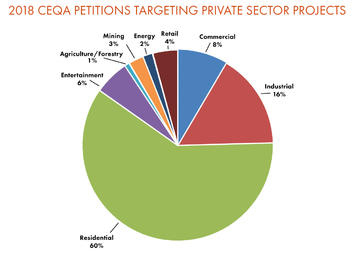
Although Governor Gavin Newsom promised to deliver 3.5 million new housing units in eight years, California severely missed this mark: as reported by the Public Policy Institute of California, housing production actually decreased during each of the past 2 years, and in 2019 is on track to fall about 80% short of the annual mark required to build 3.5 million new homes in 8 years. At this pace, it will take 39.6 years for the Governor to achieve his 8-year goal.
One clear culprit in the housing crisis is the lengthy and costly environmental review process required under the California Environmental Quality Act (CEQA), even for housing that complies with local General Plans and zoning codes, and the hundreds of applicable environmental, health, safety, and labor laws and regulations.
After new housing is finally approved, any party can – even anonymously – file a CEQA lawsuit seeking to block the housing for “environmental” reasons, resulting in costly, multi-year delays. As explained by the non-partisan Legislative Analyst’s Office in its report on “California’s High Housing Costs: Causes and Consequences:”
Environmental Reviews Can Be Used To Stop or Limit Housing Development. The California Environmental Quality Act (CEQA) requires local governments to conduct a detailed review of the potential environmental effects of new housing construction (and most other types of development) prior to approving it. The information in these reports sometimes results in the city or county denying proposals to develop housing or approving fewer housing units than the developer proposed. In addition, CEQA’s complicated procedural requirements give development opponents significant opportunities to continue challenging housing projects after local governments approve them.
Read the full report at Chapman.edu. (link opens in new window or tab)
Jennifer Hernandez is a partner and leads the West Coast land use and environment practice group of Holland & Knight, LLC, an international law firm.












